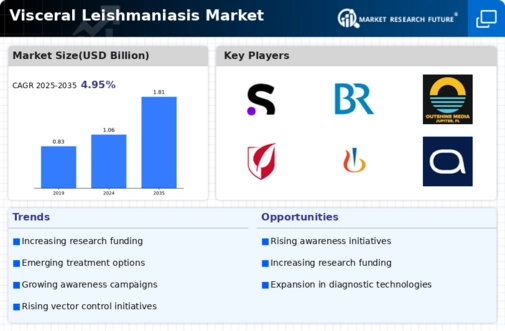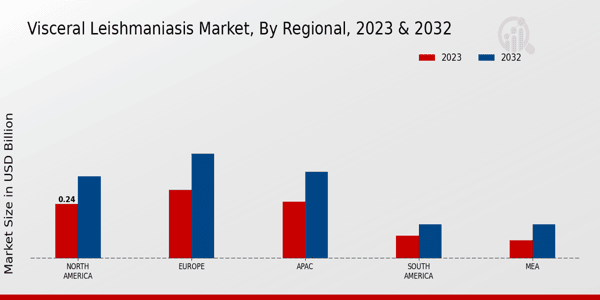Rising Awareness and Education
Rising awareness and education regarding visceral leishmaniasis are contributing to the growth of the Global Visceral Leishmaniasis Market Industry. Public health campaigns and educational programs are essential in informing communities about the disease's transmission, symptoms, and prevention strategies. Increased awareness can lead to earlier diagnosis and treatment, reducing morbidity and mortality rates associated with the disease. As healthcare providers and non-governmental organizations intensify their efforts to educate at-risk populations, the market may see a corresponding increase in demand for diagnostic tools and treatment options, further driving market growth.
Advancements in Treatment Options
Recent advancements in treatment options for visceral leishmaniasis are propelling the Global Visceral Leishmaniasis Market Industry forward. Innovative therapies, including liposomal amphotericin B and miltefosine, have shown improved efficacy and safety profiles. These developments are crucial as they address the limitations of traditional treatments, which often have severe side effects. The introduction of new formulations and combination therapies may enhance patient compliance and treatment outcomes. As a result, the market is expected to witness a surge in demand for these advanced treatment modalities, potentially leading to a market value of 1.06 USD Billion by 2024.
Government Initiatives and Funding
Government initiatives and funding aimed at controlling visceral leishmaniasis are vital drivers of the Global Visceral Leishmaniasis Market Industry. Various countries have implemented national programs to combat the disease, focusing on vector control, surveillance, and treatment accessibility. For instance, the Indian government has launched initiatives to reduce the disease burden in endemic states. Increased funding from international organizations and partnerships with local governments may further enhance research and development efforts, leading to innovative solutions. This collaborative approach is likely to foster a more robust market environment, supporting growth projections of 1.81 USD Billion by 2035.
Emerging Markets and Economic Growth
Emerging markets, particularly in developing regions, are presenting new opportunities for the Global Visceral Leishmaniasis Market Industry. Economic growth in countries such as India, Brazil, and Bangladesh is likely to enhance healthcare infrastructure and access to medical services. As these nations invest in improving their healthcare systems, the demand for effective visceral leishmaniasis treatments is expected to rise. The projected compound annual growth rate (CAGR) of 4.96% from 2025 to 2035 indicates a promising outlook for the market, as more patients gain access to necessary care and treatment options.
Increasing Incidence of Visceral Leishmaniasis
The Global Visceral Leishmaniasis Market Industry is experiencing growth due to the rising incidence of visceral leishmaniasis, particularly in endemic regions such as South Asia, East Africa, and parts of South America. The World Health Organization reports that the disease affects thousands annually, with a significant number of cases unreported. This increasing prevalence drives demand for effective diagnostics and treatment options, contributing to the market's expansion. As awareness grows, healthcare systems are likely to allocate more resources toward combating this neglected tropical disease, thereby enhancing the overall market landscape.













